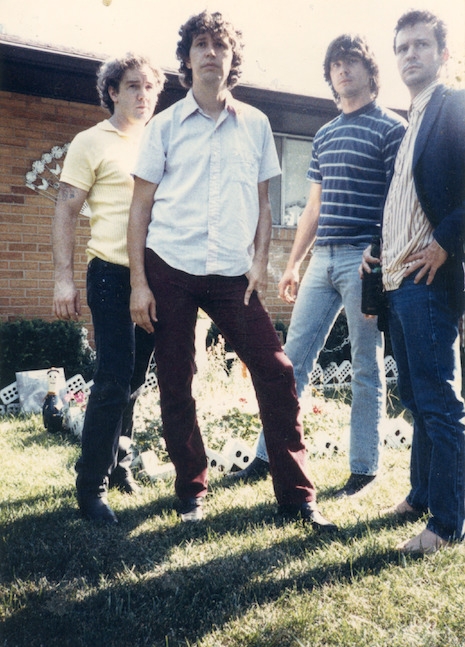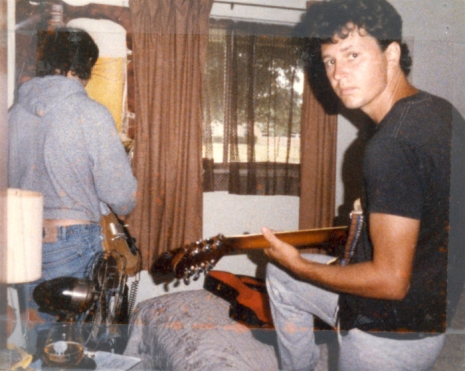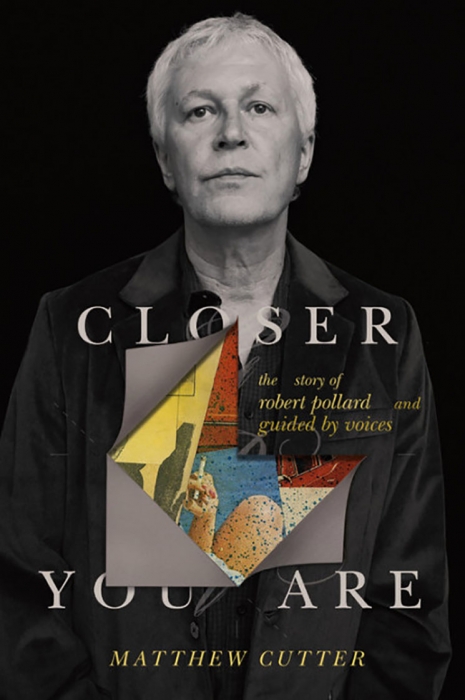
Photo shoot for the Guided By Voices album ‘Sandbox,’ 1987. (Courtesy: Robert Pollard)
Robert Pollard, majordomo for Guided By Voices and a host of other projects, isn’t just a prolific songwriter, with over 2,000 published tunes; he’s also one of the best. Pollard’s greatest songs are up there with the finest rock-n-roll ever committed to wax. I’m convinced the Dayton, Ohio, native will one day be called a “national treasure,” but for now, he’s a cult artist with a fanatical following that gobbles up everything he produces—which includes over 100 albums. But it was a long road to respectability and success for Pollard. It would be years before very many people heard Guided By Voices, and along the way, nearly everyone close to him said he should quit fooling around with this music thing.
One of Bob’s early, pre-Guided By Voices undertakings was dubbed Acid Ranch, an endeavor that also included future GBV members Mitch Mitchell and Bob’s younger brother, Jimmy. The trio recorded stealthily in Bob’s basement studio, which he named “the Snakepit.” They had the freedom to do whatever they wanted—both musically and otherwise—and shit did get wild.
Acid Ranch is a key element in Robert Pollard’s development as a songwriter, but it hasn’t been recounted in much detail. That’s about to change with the upcoming biography, Closer You Are: The Story of Robert Pollard and Guided By Voices. Dangerous Minds is happy to have the Acid Ranch section of the book to share with you.
“The most interesting, spontaneously creative, and psychotic, moronic thing we did, we labeled Acid Ranch,” Bob recalls. “You know, secretly. In the lab.” It was the secret part that allowed them to experiment so freely. “Acid Ranch was fearless and ridiculous, because we knew no one would ever hear any of it.”
Recording sessions in the Snakepit circa 1981–1982 were extemporaneous, marathon affairs accompanied by copious amounts of beer, pot, and coke. “We’d go to the point of semi-exhaustion.”
They turned on all the amps, started the tape rolling, and recorded everything—song, interview, or fart. The plan was total creativity, and beyond that there were no further rules. Bob experimented with vocal delivery, falsetto, harmonies, wordplay, and accents ranging from British to a carnival barker’s brassy tone.

Jimmy Pollard (left) and Bob Pollard (right), 1982. (Courtesy: Robert Pollard)
They got the name Acid Ranch from Spahn Ranch, the Manson’s Family’s hideout, but it was also a play on acid rain. It was only one of the band names Bob and Mitch—and Jimmy once he was back home—recorded under, but it was a favorite. (They were Mailbox when a drum machine was included. “Mailbox was a little bit more refined,” Bob says. “We were influenced by the Smiths and shit.”)
They played whatever was at hand: someone would bang out a rhythm on the clothes dryer or a plastic bucket, Bob played an acoustic guitar or Mitch played bass, they warbled a cappella barbershop harmonies, or even used squeaking squeeze toys—as in the song “Mongoose Orgasm,” a frantic blood relative to the Residents’ Duck Stab and Pink Floyd’s “Several Species of Small Furry Animals Gathered Together in a Cave and Grooving with a Pict.”
Bob and Jimmy did off-the-cuff episodes of what they called The Frank and Candid Show: Bob was the host, and Jimmy the Ed McMahon–style sidekick. They’d establish a scenario and Bob and Jimmy would improvise a skit. These sessions went on for two or three hours, sometimes more.
“Then we’d stop, get some more beer,” says Bob, “smoke a little.” Only after they were finished recording did they listen back, assigning each song or segment a title and writing down notes. “We always thought it would be about six or seven songs, but it was like eighteen.”
“We did acid a few times,” Bob recalls. “We’d end up naked and laughing our asses off at our brotherhood.” Once, they were in such a state when the doorbell rang.
“Hold on, I have to go get that,” Bob said—entirely reasonably, it seemed to him.
He went upstairs and answered the door, bare-ass naked, to find a pair of surprised Jehovah’s Witnesses. They apologized and said they’d come back.
“Nooo!” Bob protested, laughing, just about chasing them down the sidewalk. “Come on in, I want to hear what you have to say. I’m ready!”
At times—sometimes more noticeably, sometimes not—the listener can hear in these recordings a distinctive sound struggling to break free from its influences. It’s not the greatest music Bob ever made, but it wasn’t meant to be. “There are about seven hardcore Acid Ranch fans out there,” he says. “That’s all they need.” But a closer look at Acid Ranch opens a window into Bob’s creative process.

Acid Ranch: Jimmy Pollard (top), Mitch Mitchell (middle), and Bob Pollard (bottom), u.d. (Courtesy: Robert Pollard)
His influences were exposed, as in the Morrison-esque “Electric Indians,” with its titular Native Americans and death-trip ruminations. But often a listener can catch sonic snippets that would later collage their way into Guided By Voices songs. It’s a strong indicator of Bob’s authorial process, banging out drafts that incorporate the best of what came before until a composition arrives in its final form. Acid Ranch’s seams are taxed to bursting with detective work for the Pollard obsessive.
The title alone of “The Megaphonic Thrift (An Odd Assembly)” invoked latter-day works. A tune called “Edison’s Memos” asked a question remarkably similar to one most GBV devotees know by heart—“Do you suppose that you could change your life? If you could then I wish you would”—a full fifteen years before the song “Cut-Out Witch” saw proper release. “It’s Weird What The People Say” began with a woman’s prim voice asking, “Bob—would you and Living Praise Choir lead us in ‘To God Be the Glory’?” to which Bob replied with golly-gee enthusiasm, “I sure will!”—another moment that would return in later recordings.
“Daily Planet” is an epic at 4:58—an apocalyptic, satirical, substance-fueled operetta detailing Superman’s accidental suicide by Kryptonite ingestion and the drama that follows. Bob played a full cast of characters. In its midst he assumed the role of Dick West—a portmanteau of DC Comics’ Dick Grayson and Wally West—to intone, “The start of the ‘Turbulent Years.’” The non sequitur fell where it was spoken, flowing from far-off cries, followed only by creaking guitar feedback against the song’s lazy bassline.
It was a wry observation on Bob’s situation; here he was settling down into a domestic existence as husband, father, teacher—but in the Snakepit, and maybe in Bob’s thoughts too, there were turmoil, unrest, and yearning. Superman was eating the Kryptonite.
Still, it’s tough to append dire omens to music that radiates such joy. “Daily Planet” closes with a peculiar monologue by Pollard, the same recording later heard closing out the final notes of GBV anthem “Alright”:
“And blowing smoke out the eyes of another, and drilling two holes in the bottom of the Earth . . . Where life could be once again like it once was, in the ice age, in a kingdom long ago, without chance, without hope, without vision, and therefore: Always creating the same effect, without ever knowing why.”
Bob pinched his nose and spoke in a nasal, British-tinged voice, especially to pronounce the word chahnce, an early experiment in accent and delivery.
Songs like “Pictures From The Brainbox” and “The Theory Of Broken Circles” again bring to mind Jim Morrison and the Doors, with Jimmy alternating between two power chords, Mitch adding a more-involved guitar layer, and Bob speak-singing verses and repeating a distinctive title phrase in melody for the chorus. “Congratulations (You’re Under Sedation)” featured Bob, Jimmy, and Mitch singing confident—and competent—three-part harmonies. What linked most of the proto-GBV tunes here was the common thread of Bob’s early delivery, still displaying—for the most part—the particular twang of the Dayton-raised.
Despite their secret origins and the certain knowledge no other ears would hear them, Bob culled and released three albums’ worth of Acid Ranch recordings in the 2000s. Hearing them is like being a fly on the Snakepit wall (just before it gets smashed). In the titles alone, one senses Bob’s familiar touchstones coming into focus: sports, women, pop culture, local history, the Golden Age of rock ’n’ roll, and of course music: “Beatles And Stones” admonishes the listener, “Don’t confuse success with luxury.” Its plaintive, self-aware sloganeering of “I want long hair! I want free love! I want no more war!” spoke to Bob’s still-private longing.
Excerpted from ‘Closer You Are: The Story of Robert Pollard and Guided By Voices’ by Matthew Cutter. Copyright © 2018. Available from Da Capo Press, an imprint of Perseus Books, LLC, a subsidiary of Hachette Book Group, Inc.

Matthew Cutter’s authorized biography of Robert Pollard will go on sale August 21. The book is essential reading for all fans of Guided By Voices, as well as anyone interested in the history of American indie rock. There are a number of pre-order links on Da Capo’s site, including one for Amazon.
The three Acid Ranch albums that have been released are Some of the Magic Syrup Was Preserved (2002), A Manifesto of Fractured Imagination and Wreckless Living (2005), and The Great Houdini Wasn’t so Great (2007). These were limited, vinyl-only pressings, and all three are long out of print. There are currently copies of each record for sale on Discogs, but they’ll set you back a bit.

Hand-screened cover of ‘Manifesto of Fractured Imagination and Wreckless Living’ (using a Helen Reddy jacket).
On July 3, 1994, MTV aired a piece on Guided By Voices. It came as the band was on the rise, thanks to the overwhelmingly positive press coverage of their fantastic new album, Bee Thousand, and praise from the likes of Lee Renaldo (Sonic Youth), who appears in the clip—as do the three former members of Acid Ranch.
Previously on Dangerous Minds:
Guided By Voices on ‘Oddville, MTV,’ 1997